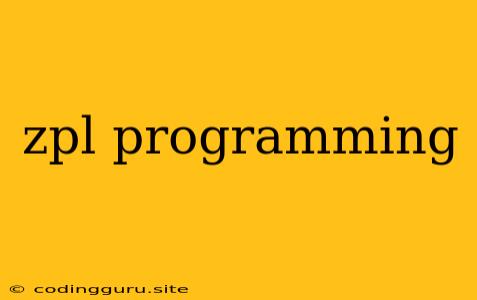Unlocking the Power of ZPL Programming: A Comprehensive Guide
ZPL, short for Zebra Programming Language, is a powerful tool for designing and printing labels using Zebra printers. But understanding ZPL can feel daunting at first. This comprehensive guide will walk you through the fundamentals of ZPL programming, empowering you to create professional, customized labels with ease.
What is ZPL Programming?
Imagine a world where you can design and print labels with precise control over every detail: the size, shape, font, barcode type, and even the location of each element. This is the power of ZPL programming. It allows you to create custom label templates that meet your specific needs, going far beyond the limitations of pre-defined label formats.
Why Choose ZPL Programming?
ZPL offers a wide range of benefits for label design and printing:
- Flexibility: Design labels of any size, shape, and complexity, with complete control over every element.
- Automation: Create automated label printing workflows, saving time and reducing errors.
- Scalability: Easily adapt your label designs to different label sizes and printer models.
- Integration: ZPL commands can be easily integrated into various applications and systems.
Getting Started with ZPL: Your First Steps
1. Understanding ZPL Syntax:
ZPL commands follow a specific structure:
^XA
^FO,^A,^FD^FS
^XZ
- ^XA: Start of the ZPL code
- ^FO<horizontal position>,<vertical position>: Sets the position of the text on the label.
- ^A<font size>,<font style>: Specifies font attributes.
- ^FD<text to print>: Defines the text to be printed.
- ^FS: End of the text field.
- ^XZ: End of the ZPL code.
2. Essential ZPL Commands:
- ^FO: Defines the position of an element.
- ^A: Sets font attributes like size, style, and weight.
- ^FD: Prints text.
- ^BY: Creates a barcode.
- ^CI: Inserts a graphic image.
- ^XZ: Ends the ZPL code.
3. Creating Your First Label:
Let's create a simple label with the text "Hello, World!"
^XA
^FO50,50^A0,20^FDHello, World!^FS
^XZ
This ZPL code will print the text "Hello, World!" at position 50,50 on the label, using a font size of 20.
4. Using ZPL with Zebra Designer:
Zebra Designer is a user-friendly software that simplifies ZPL programming. It allows you to visually create labels and then automatically generate the corresponding ZPL code.
Tips for Effective ZPL Programming
- Start simple: Begin with basic label designs and gradually add complexity.
- Document your code: Use comments to explain your code and make it easier to understand.
- Test thoroughly: Print your labels and carefully examine the output to identify any errors.
- Refer to the ZPL documentation: Utilize the official ZPL documentation for a complete reference of commands and their usage.
Advanced ZPL Programming:
Beyond basic labels, ZPL enables you to:
- Create complex barcodes: Utilize ZPL commands for generating QR codes, Data Matrix codes, and more.
- Integrate images: Add company logos or product images to your labels.
- Control print settings: Optimize print quality, paper type, and other printing parameters.
Troubleshooting Your ZPL Code
- Check for syntax errors: Ensure that your ZPL commands are properly formatted and spelled correctly.
- Use debugging tools: Zebra Designer and other tools offer debugging capabilities to help you identify errors.
- Test in different environments: Run your code on different printers and verify that the output is consistent.
Conclusion
Mastering ZPL programming unlocks a world of possibilities for creating custom, professional-grade labels. Whether you're automating label printing, optimizing workflow, or designing visually compelling labels, ZPL offers a powerful solution. This guide has provided a solid foundation for understanding the basics of ZPL programming. As you continue to explore ZPL, you'll discover its versatility and its ability to meet the unique demands of your label printing needs.
